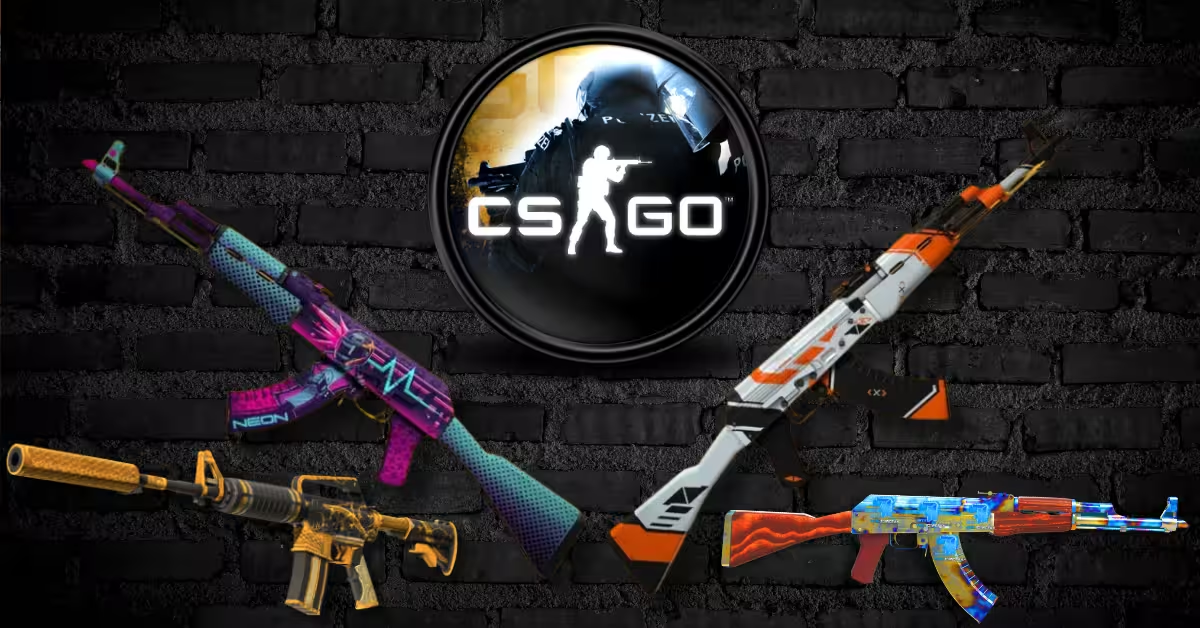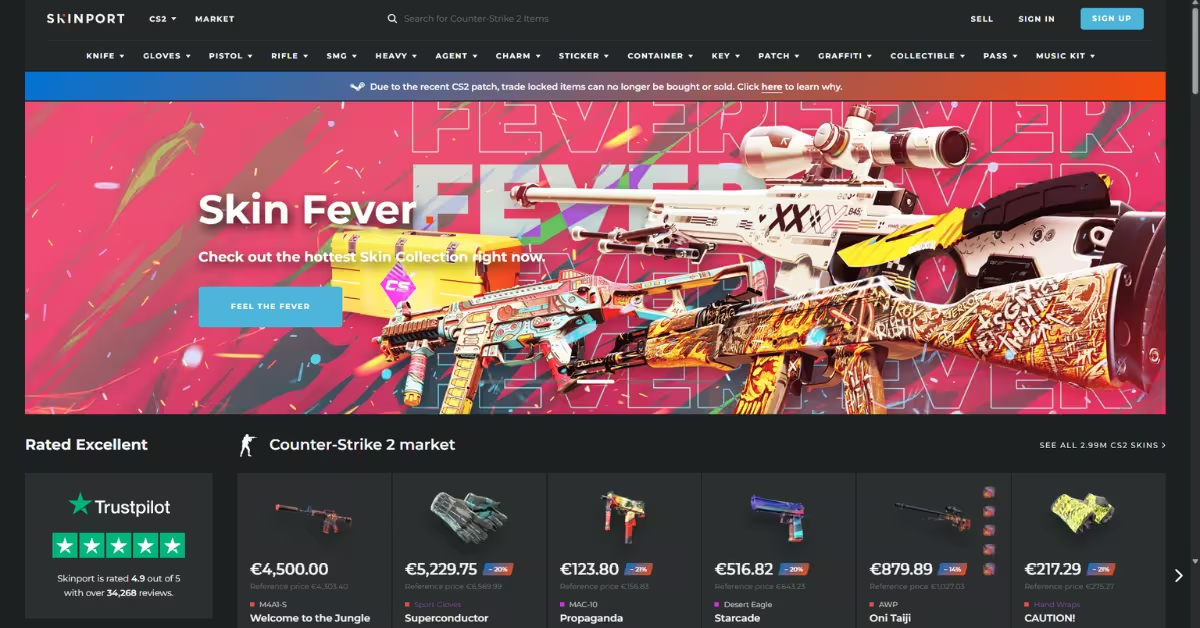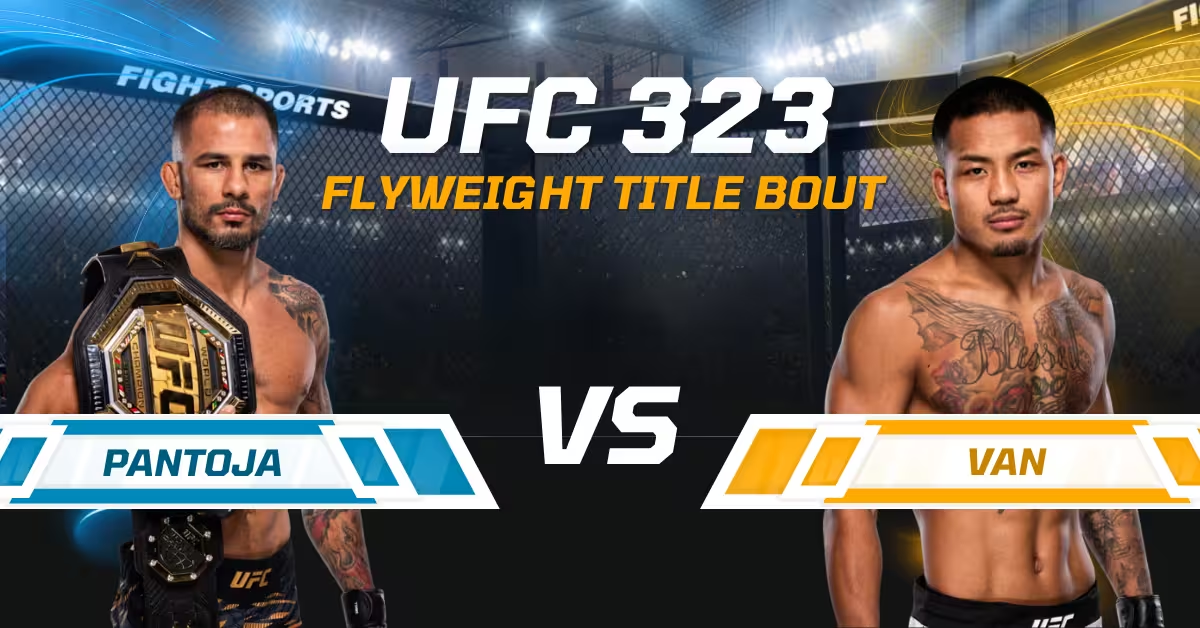Counter-Strike 2 Skin Betting: Risks, Regulation & the Next Big Scandal

The video game Counter-Strike 2 wasn’t released with the intent to revive an economy; the Valve Corporation wanted to put a new spin on a classic.
But old habits die hard, and as soon as it came out, the OG CS: GO days were being relived. Players weren’t only chasing higher rankings; they also wanted the relics of the past. Those skins that once sat forgotten in Steam inventories? They were once again speculative assets to be traded, sold, and, inevitably, gambled.
A rare weapon finish in CS2? That can sell for more than an entire semester of college; it’s big money. And that kind of value doesn’t stay confined to the game; it’s leapt out into official marketplaces, where a whole black (or grayish)market has re-emerged.
What goes on in this grayish market? Unregulated betting, a lot of game influencer hype, and digital items that are acting a little too much like they’re real money.
Skin gambling isn’t a new thing, but the CS2 era has given it a resurrection. Because the Steam API is still functioning as the gateway, offshore sites and crypto-based casinos are at it again and using players’ inventories as collateral. The lines that separate the collector, trader, and gambler? They’ve been, for all intents and purposes, erased.
Why did it happen in the first place, and why is it happening again? That’s what we wanted to find out! We’ll examine how the market ballooned into a multi-billion-dollar ecosystem, why regulation is so far behind, and how the next scandals are already coming down the pike. What’s happening in CS2 at the moment isn’t a nostalgia thing; it’s a stark reminder that every time skins become valuable, someone figures out how to turn them into a bet!
What Is Skin Betting & Why It’s Back
Skin betting (aka skin gambling) is the practice of using virtual in-game items, which are cosmetic “skins,” as a currency to gamble on games of chance or eSports matches.
Rather than wagering money, players bet their digital collectibles, and they have real-world monetary value. The concept took off in Counter-Strike and a few other games years ago, and now Counter-Strike 2 has brought it back. How? Because CS2 inherited CS: GO’s massive library of skins and introduced new ones, which rekindled the community’s obsession with collecting and trading weapon finishes. Add in the chatter around CS2’s vastly better graphics and a super competitive scene, and you have a perfect storm for skin betting’s resurgence.
How does skin betting work? Well, since players can’t gamble skins within CS2 itself (Valve forbids it), a cottage industry of third-party services fills the void. The most common avenues include the following:
- Third-Party Betting Platforms – Websites that allow users to deposit skins from their Steam inventory and use them to place bets. This can be betting on eSports match outcomes (like Team A vs Team B in a CS2 tournament) with skins as the wager instead of cash. If your pick wins? You get more skins back. But if they lose, you forfeit your deposit. The platforms turn skins into poker chips.
- Jackpot and Roulette Sites – These are the digital lotteries where players contribute skins into a common pot, and one random participant wins the whole pool. The more your skins are worth, the higher your chance of winning becomes. And roulette or coinflip games let you bet skins on a color or side, casino-style, with automated “provably fair” algorithms deciding winners; at least, that’s how it’s supposed to work in theory.
- Case Opening and Loot-style Games – Some sites mimic the in-game loot box experience, but with higher stakes. You pay with either skins or crypto to open a virtual case on the platform that can drop skins that range from a junker to a jackpot. It’s like a slot machine; the anticipation of possibly unboxing a rare CS2 knife skin keeps people coming back.
Skin Trading as Gambling Collateral
Even without formal “casino” games, people will engage in speculative trading or high-stakes trades that amount to gambling. Two players might agree to a coin flip where the winner keeps a coveted skin. There are also betting pools and fantasy leagues where entry fees are paid in skins and winners earn prize pools of skins.
Counter-Strike 2’s launch in late 2023 breathed new life into all of these activities. The legacy skins from CS: GO carried over into CS2, which gave vet players valuable inventory to trade and bet.
And Valve’s shift to the new game sparked a ton of interest; CS2 hit over 1.8 million concurrent players at its peak, with a huge audience who were interested in skins. The demand drove skin prices up: when a single AK-47 skin could be worth hundreds or thousands of dollars, wagering it for a chance to hit an even bigger payout is pretty tempting.
The culture surrounding skins also reignited; streaming and social media made skin unboxings and high-value trades into spectator events, which organically fed into the betting scene.
The Scale of the CS2 Skin Economy
To appreciate why skin betting is such a big deal, you need to understand the sheer scale of the CS2 skin economy. The in-game items are virtual, but they carry very real price tags.
Some rare CS2 skins are worth more than a new car or a house. The legendary Souvenir AWP Dragon Lore sniper rifle skin has sold for over $400,000 in Factory New condition, and top-tier knife skins routinely fetch five or six figures. In mid-2024, a single AK-47 skin (a Case Hardened pattern #661) was brokered for around $1,000,000; it was the first CS2 item to hit the million-dollar mark. When cosmetic pixels command such insane amounts, it’s not a surprise that they’ve become the currency of a high-rolling realm.
As for the overall market size, when CS2 launched, the combined value of all CS skins in circulation went nuts. According to Bloomberg, in March 2025, the total market cap of CS2 skins hit $4.3 billion, an all-time high. And a month later, it climbed to $4.5 billion. For context, that’s bigger than the valuation of some real-world companies and well above the prize pools of all major eSports events combined.
On a daily basis, it’s estimated that hundreds of thousands of dollars’ worth of skins trade hands through various marketplaces. In February 2025 alone, over 6.9 million unique visits were recorded across 50+ skin gambling and trading sites worldwide. The top skin sites each drew over 1 million visits that month, which surpassed the traffic of legit online casinos. This level of activity only underscores how mainstream and lucrative the skin economy has gotten.
Skin Trading Platforms
There are a handful of third-party platforms that facilitate the bulk of skin trading; they act like the Wall Street of CS2 skins. Sites like CS.Money, BitSkins, Skinport, and Buff let players buy, sell, or swap skins for real money (or for other skins), and they operate in a gray area that’s outside of Valve’s Steam Marketplace.

Skinport, which is a marketplace based in Germany, has over 600,000 skin listings at a time and boasts higher web traffic than most of its competitors combined. The platforms provide cash-out avenues: a player can turn a coveted skin into real dollars (minus a fee) by finding a buyer on Skinport or BitSkins, which Valve’s marketplace doesn’t directly allow; Steam balances can’t be withdrawn as cash.
The liquidity has driven the skin economy’s growth, and it attracts serious traders and investors. There are people who treat high-tier skins like an asset class, just like sneakers or baseball cards, and they buy low and sell high for a profit, or they hold onto rare items as long-term investments.
Collectors, Traders, & Gamblers
The convergence of collectors, traders, and gamblers makes the CS2 skin market really quite dynamic! On the one hand, you have the collectors who pay top dollar to own ultra-rare skins (like factory-new knives with one-of-a-kind patterns).
On the other hand, there are the traders who flip skins across sites to exploit price differences or trends. And overlapping with both are the gamblers, some of whom are regular CS2 players just risking a spare skin on a fun bet, and others who are high-stakes speculators wagering inventory valued in the tens of thousands.
Why Skin Betting Thrives Despite Regulation
If skin gambling has led to scandals and lots of legal scrutiny in the past, how is it still happening? The answer? Psychology, youth-friendly access, and regulatory evasion tactics that allow this particular form of gambling to operate almost unchecked.
The Psychology: Gambling Masquerading as Gaming
Skin betting cleverly gamifies gambling in a way that hooks players who probably wouldn’t go to a traditional casino. The bright colors, exciting animations, and game-like interfaces of skin gambling sites make the experience feel like it’s just another video game and not a risky wager.
For CS2 players, betting a skin doesn’t “feel” like they’re spending money, even though that skin could be worth $50 or $500. It’s a virtual item you may have earned or traded for, so putting it on the line triggers less mental resistance than whipping out a credit card. The illusion of “virtual” stakes softens the perception of risk.
Psychologically, it diffuses the fear: losing a bet means losing a cool item from your inventory, which some players rationalize differently than losing hard cash, even though that item had cash value.
And the gambling mechanisms tap into the same reward circuits as any other form of betting. The near-misses, the suspense of a spinning roulette, the flood of dopamine when you win; it’s all textbook gambling psychology, and it’s camouflaged behind the fun veneer of CS2-themed graphics and memes.
Most skin gambling sites intersect with the gaming community, and they sponsor popular streamers or YouTubers who portray the betting as entertaining content. A viewer sees their favorite CS2 streamer hitting a jackpot or unboxing a rare skin on a gambling site and is like, “Hey, that looks fun and easy!” The promotional language frames it as a game or a “giveaway” instead of outright gambling. All of this helps skin betting thrive because it doesn’t carry the same social stigma or self-awareness that walking into a casino might; it’s all a part of the gaming culture.
Underage Access, Anonymity, and the Low Barrier to Entry
One of the most troubling reasons skin betting endures is how easily young people can access it. Traditional online gambling sites all require age verification (18+ or 21+) and identity checks.
Skin gambling sites? They just require a Steam login. If a 15-year-old has a Steam account with some CS2 skins in it, they can start betting without an ID, a credit card, or any “are you old enough?” prompts.
Studies in the UK have found that adolescents are engaging in skin gambling at startling rates, more so than young adults. 11–14 year-olds were more than twice as likely to have gambled skins as 22–24 year-olds, which suggests that these sites are introducing gambling behaviors to kids at an early age. The anonymity of using a Steam account and, in many cases, cryptocurrency for transactions means that minors can easily get access.
Because skins are acquired through gaming, kids accumulate some by playing CS2 or trading with friends. To them? Betting a skin might feel like using a house chip; they didn’t directly pay $20 for that AK-47 skin (maybe they unboxed it or got it as a gift), so gambling with it feels like it’s got low stakes. That is, until they lose an item of real value or, worse, get hooked on the rush and start chasing losses by buying more skins to gamble. The social aspect shouldn’t be underestimated either: teenagers in gaming communities egg each other on, brag about wins, and bully those who don’t partake, which normalizes the behavior.
How Skin Sites Evade Regulation
Even where governments and platforms try to clamp down, skin gambling sites have proven to be very adept at dodging rules. A big part of this is operating in legal gray zones or offshore jurisdictions. Most of the websites are registered in countries with lax online gambling laws, or they fly under the radar by not being explicitly categorized as “casinos.”
They’re dealing in virtual items, and outdated laws don’t clearly define it as “something of value,” and that’s a loophole that’s exploited in places like the U.S., where skin betting isn’t explicitly illegal nationwide due to the ambiguity around if skins count as money.
Another evasion tactic? Using cryptocurrency and third-party payment systems. Instead of traditional banking, which can be monitored or blocked, skin gambling sites let users buy credits via Bitcoin or other crypto, or they’ll award winnings in crypto. This makes transactions much harder to trace and regulate. It also helps with the anonymity factor; a gambler can deposit skins, the site instantly sells those for crypto behind the scenes, and later pays out in crypto or via a skin withdrawal.
Without clear fiat money trails, regulators have a harder time proving gambling activity or money laundering. Valve’s Steam API enables the sites to connect to user inventories to transfer skins, but Valve’s hands-off approach historically allowed rampant abuse. Although Valve officially condemns skin gambling and, in 2016, took steps to shut down some sites, the reality is that many platforms still hook into Steam to make bets and pay-outs possible. As long as that functionality remains (and it has to, for legit trading), determined operators will find ways to use it.
The sites also mask their operations; they’ll frequently rebrand or change domains if one gets banned. A site that was shut down today can reopen under a slightly different name next week, and players migrate there, and they’re told to do so by the influencers who are sponsored by the sites.
Some claim to be “provably fair,” offering algorithms that users can supposedly audit. But without independent oversight? Those claims are basically smoke and mirrors, as there’s no gaming commission auditing the code behind a CS2 roulette site.
Lessons from the CSGO Skin Betting Scandals
To understand how we got here, we have to go back and look at the notorious scandals of 2016 that first put skin gambling on the map for most of us.
Counter-Strike: Global Offensive (CS: GO), which was the predecessor to CS2, was the epicenter of the original skin betting craze, and by mid-2016, it was estimated that $5 billion worth of virtual goods had been wagered through skin betting sites. And what set off alarm bells was not only the money; it was who was involved and how the system was being abused.
The CS:GO Lotto Fiasco and YouTuber Promotions
In June 2016, it was revealed that two popular gaming YouTubers, Trevor “TmarTn” Martin and Tom “Syndicate” Cassell, had been promoting a skin gambling site called CSGO Lotto without disclosing that they owned the site.
This was the first scandal to be made public; the influencers made videos showing themselves winning big on CS: GO Lotto, and they encouraged their young fans to try it as a “quick and easy way to get cool skins or make money.”
It was false advertising: the contests looked legit and winnable, but the whole thing was rigged in their favor, and viewers weren’t told about the conflict of interest. When it came to light after some good ol’ fashioned sleuthing by the community, it sparked a ton of justified outrage.
It unearthed how unregulated and unethical the skin betting scene had become; the influencers were trusted figures in the gaming community, and they lured minors into gambling under false pretenses. The backlash was intense; mainstream media picked up the story, and it didn’t take long for lawyers and regulators to get involved.
Valve’s Crackdown and the Aftermath
Public and legal pressure forced Valve (the company behind CS:GO/CS2 and Steam) to act. In July 2016, Valve issued cease-and-desist notices to over 40 skin gambling sites, warning them to stop using Steam’s API for commercial gambling activities.
Around the same time, separate lawsuits were filed against Valve and other gambling sites, which were accused of facilitating illegal gambling and exposing minors to it. Valve’s stance was that any gambling with skins violated Steam’s terms of service, and they moved to shut it down on paper. As a result, most prominent skin betting sites closed or went underground in late 2016, and the live-streaming platform Twitch also banned any content that promoted unregulated gambling sites during that period.
The scandal and subsequent crackdown did lead to some changes. For one, it educated a lot of the gaming public about the risks and shadiness in this space. The term “skin gambling” became synonymous with underage betting and scams, and Valve made a significant change in 2018 by adding a 7-day trade hold on CS:GO items, which meant you couldn’t instantly trade a skin to someone else. The move was explicitly designed to curb rapid trading and, by extension, gambling bots. It throttled the skin economy for a time and proved that Valve can influence the ecosystem when it wants to.
But did we really learn anything? Arguably, the root incentive, which is valuable skins that are convertible to cash, is still here. Some sites tried to rebrand as more “legit” eSports betting platforms that have licenses in places like the Isle of Man or Curaçao, and others changed to different games or pseudo-currencies. A few influencers got slaps on the wrist; TmarTn and Syndicate faced an FTC investigation for nondisclosure, but they settled without having to admit to any wrongdoing. The community’s outrage eventually subsided, and gamblers simply moved to whatever new method popped up next.
The most concrete outcome was that Valve started policing its API more, at least for a while. They banned bot accounts, and in 2019, they updated policies to forbid Steam accounts from being used in commercial gambling or trading services. Yet here we are in 2025, and skin betting is back in full force with CS2. It seems that the scandals of 2016 did serve as a cautionary tale, but not as a permanent deterrent.
The lure of easy money and the excitement of the wager proved to be too enticing; as soon as CS2 rekindled skin mania, a new generation (and some vets) hopped right back in. The lesson learned? That regulators and Valve can slow it down, but where there’s an open market and valuable skins, the gambling will find a way.
If we’re being honest, it just looks like the industry learned to cover its tracks by using opaque crypto transactions, fine-print disclosures, or off-platform promos instead of getting rid of the bad behavior.
CS2’s New Risks: History Repeating Itself
Counter-Strike 2 is the newest version of the game, but it’s still got most of the old vulnerabilities and temptations that came with the OG game. As skin betting ramps up again, we’re already seeing familiar patterns of exploitation, suggesting that history always repeats itself; it just does it with a new logo.
Loopholes in Trading and ‘API 2.0’
Valve didn’t overhaul the skin trading system for CS2; the game runs on Steam just like CS:GO did, and players’ inventories moved over. That means the fundamental loophole that enables skin gambling is still alive and well.
If anything, CS2’s launch reopened certain loopholes that had closed. During the transition, there were reports of new third-party services popping up that use automated Steam accounts (bots) to manage inventories, just like the old gambling sites did. Valve’s trade holds and anti-bot measures are still in place, but enterprising sites always find workarounds, like rotating through pools of “smurf” accounts or utilizing the Steam API in creative ways that Valve’s monitoring hasn’t caught.
A new vector is how CS2 integrates with the broader Steam economy; CS2 introduced some changes in how item data is handled (like different item IDs or the way skins are verified in Steam’s new UI). Some speculate that these changes could be leveraged to create new kinds of betting systems or scams.
There’s been talk about “skin escrow” services, which is where a third-party holds your item during a tournament and automatically pays it out to the winner, which is an unofficial betting pool via Steam trading. While this isn’t inherently malicious, the systems are ripe for abuse if the escrow service is itself rigged or disappears with the goods.
‘Provably Fair’ Without Proof
CS2 gambling websites now loudly advertise “provably fair” algorithms for their games (coin flips, case openings, etc.), and it’s a term that’s been borrowed from crypto casinos.
They provide a hash or seed you can theoretically use to verify outcomes weren’t tampered with. But without any independent audits? Players are taking the sites at their word. There is no regulator forcing these algorithms to be truly random or fair. A site could manipulate results (especially for high-value bets), and most users would have zero clue about how to catch it. The illusion of transparency makes most players feel safer to bet larger amounts, which is a new risk in the CS2 era; it’s a false sense of security.
No external authority is verifying these “proofs,” and outcomes could be rigged, just like the CS:GO Lotto owners rigged their wins. The difference is now the sites hide behind math gibberish that 99% of players won’t verify, and there’s no FTC knocking on the door unless a whistleblower starts snitching.
Streamers, Influencers, and the New Hype Machine
The biggest red flag that echoes 2016? The renewed involvement of streamers and influencers who are promoting skin gambling. Despite Twitch officially banning sponsorships or promo of skin betting sites in 2023, a recent investigation found that over 100 of the most-watched CS2 streamers on Twitch were still sponsored by skin gambling sites in 2025.
They might not be as brazen as TmarTn and Syndicate were with CS:GO Lotto, but they’re finding ways to advertise, be it through discount codes, overlays, or directing fans to “check out” certain websites. Twitch has said it’s “digging into” any and all violations, but most of the streamers are still active and pushing the envelope.
As long as the streamers bring Twitch viewership and the content isn’t overtly against the rules (some will stream themselves opening cases or doing coinflips without directly saying the site name, enforcement is way behind. The result is thousands of viewers, many of them underage, who are being exposed to skin gambling by charismatic personalities that they trust.
We’re also seeing YouTube content increase; “$10,000 CS2 case battle!” or “Betting my Dragon Lore, insane win!” This all mirrors the hype-y content of the past; it’s just on a new platform and with new voices. The influencer marketing is more sophisticated now: some streamers allegedly get a cut of referral losses (a dubious practice where they earn more if their viewers lose more on the site), which incentivizes them to encourage heavy betting.
It’s not a reach to envision a new scandal where a beloved CS2 content creator is outed for secretly being part-owner of a gambling site or for faking wins on stream. Such conflicts of interest are already circulating in the community; skepticism is growing about certain streamers who always seem to win big in their videos, allegedly.
The Regulatory Void
The reason skin betting goes on pretty much unchecked is because it exists in a regulatory void, an empty space where traditional gambling laws haven’t caught up to the new form of digital wagering. Around the world, governments are playing whack-a-mole with skin gambling, and that means a host of responses and lots of gray areas.
In the U.S., there’s no federal law explicitly covering skin gambling. Gambling laws are largely state-by-state, and because skins are virtual items, it’s ambiguous if betting them qualifies as illegal gambling or not. The Illegal Gambling Business Act and other statutes could apply if skins are deemed “things of value,” but as of 2016, U.S. authorities hadn’t made a definitive call on this.
The lack of clarity means that most skin betting sites operate ostensibly legally by simply not being overt about cash gambling. Enforcement has been minimal; we saw a civil lawsuit against Valve (dismissed in 2020) and some state-level murmurs, but no kind of sweeping action. The U.S. is a huge market where underage skin gambling is happening, and it’s largely unpoliced.
The UK actually has acknowledged skins as falling under gambling laws; the UK Gambling Commission stated that if you can cash out skins or convert them, betting with them meets the definition of gambling (skins are considered “money’s worth”).
This means, in theory, the sites need a license to operate in the UK. In 2017, UK authorities prosecuted a couple of people for running an unlicensed FIFA skin betting site that catered to minors. The Commission actively tries to block or shut down skin sites accessible in Britain. The problem is enforcement: the websites are usually overseas. So while the UK recognizes the issue (and a recent government report urged urgent global action on skins gambling), British kids can still access sites until they’re specifically blocked.
Other European countries vary; some, like Norway or France, have strict online gambling rules that could encompass skins, and others haven’t said much at all. The EU doesn’t yet have a unified stance on it. Europe is more cognizant of the problem than the U.S., but practically speaking, many European players still gamble on these sites by getting around any IP blocks that are put in place.
Asia has an absolutely massive gaming market and has seen a ton of growth in skin trading and gambling, partially in China, and most of the high-end skin buying (and possibly betting) is driven by Chinese collectors and whales.
China’s laws on online gambling are super strict (it’s mostly illegal), but enforcement is focused on traditional casinos and sports betting, and not so much on informal skin websites.
In South Korea or Japan, the legal focus has been more on loot boxes (they are considered gambling-lite) instead of on skin betting. Most Asian countries haven’t addressed skins in legislation. So while legally unlicensed gambling is not allowed in most of Asia, in practice, skin betting sites are easily accessible and there’s little evidence of crackdowns targeting them.
Then we have the Steam platform’s own rules and the role of Valve. Valve’s Steam Subscriber Agreement technically prohibits using Steam for commercial purposes like gambling or running a sportsbook with Steam inventories. Valve periodically bans accounts suspected of being gambling bots (like the mass bans in 2023 that targeted accounts holding thousands of skins linked to betting operations).
They also tightened rules for CS2 tournament organizers, threatening to revoke event licenses if organizers feature sponsorships from skin betting sites. These are definitely steps in the right direction, as they show Valve acknowledging that they have some responsibility. But enforcement by Valve has been inconsistent over the years. The sheer volume of Steam activity makes it really hard to police every gambling-related transaction. Valve usually only acts when there’s a public scandal or legal risk.
And then there’s the crypto element; most skin betting platforms now integrate cryptocurrency, which adds more regulatory dodges.
Crypto transactions aren’t controlled by banks or governments, so even if authorities attempt to choke off payment processing (a tactic that’s used against online casinos), crypto lets the sites continue business as usual. It also complicates jurisdiction; is a bet placed in Bitcoin subject to country X’s laws or country Y’s laws? The confusion plays to the site’s advantage.
What could future regulation entail? Here are some possibilities:
- Explicit Classification of Skins as Gambling Instruments: Laws could be updated to clearly state that wagering skins constitutes gambling. It would empower agencies to go after sites more directly and pursue charges against operators, possibly even players, although that’s less likely.
- Age Verification and KYC (Know Your Customer) Mandates: Regulators may force any platform dealing with skin transactions to implement age checks and identity verification similar to online casinos. In practice, this could mean pressure on Valve to enforce age-gating on trading or on third-party sites to require proof of ID.
- International Cooperation: Since the sites are global, we could see efforts via organizations like the European Union or other international bodies to coordinate a crackdown, share blacklists of sites, and hold platform providers accountable. The UK’s 2023 report called for this global approach.
- Valve’s Involvement: Regulators might tighten the screws on Valve to police their own ecosystem; they could threaten liability if they don’t maintain certain controls. Valve would then be encouraged or required to develop better monitoring of large skin transfers (flagging suspicious patterns that indicate gambling or money laundering) and to shut down API access for any site that doesn’t have a gambling license.
The Next Big Scandal: Predicting the Flashpoint
Look, it’s not a matter of if the next scandal will erupt, but when and how. Below are the biggest red flags and most likely flashpoints that could spark a new controversy in CS2 skin betting!
Streamer Promotion and Hidden Deals
Influencers once drove the CSGO betting boom, and they’re gonna do it again. There are creators who are promoting gambling sites via vague sponsorships or coded shoutouts. If one of them gets caught taking undisclosed payments or directing minors toward these platforms? Hoo boy, Twitch and YouTube will face some serious blowback. All it takes is one investigative report to expose the network behind those “fun little betting clips.”
Teen Losses and Public Backlash
If a teenager loses thousands of dollars’ worth of skins and blames a streamer or gambling site, that story will go viral. The combo of youth, money, and online influence is something that regulators can’t ignore forever. Political pressure will follow, and companies like Valve will be forced to react more aggressively than they did last time.
Criminal Use and Money Laundering
Then there’s the other aspect that players don’t see, and that’s organized groups using high-value skins to shuffle money across borders. Skins are really hard to trace and easy to liquidate, and that makes them perfect for laundering. If investigators tie one of these sites to criminal networks? The fallout will go way beyond eSports; it could totally change how all digital collectibles are regulated.

What Could Trigger the Next Scandal
If we had to guess what could kick off the next major controversy, we think it’ll happen from influencer-run betting events that are disguised as fan tournaments. Viewers send in skins, prizes get “drawn” live, and everything looks perfectly innocent until questions are asked about who’s winning. Add in underage fans and shady accounting? And you’ve got another public mess.
Third-party “case battle” platforms could also set it off. They’ve turned loot boxes into head-to-head betting contests, which puts two already-controversial mechanics into one package. Once someone proves that those odds are fixed, or that minors are spending serious money, the industry will have another scandal to deal with.
How Players Can Protect Themselves
The CS2 skin scene looks harmless enough, but once that money starts moving? The scams will pop up left and right. If you do trade or bet on skins, you have to do so with the same caution you would with real cash! Here’s how to do it as safely as possible:
- Be Wary of Login Requests: Counterfeit Steam pages are everywhere. One fake sign-in? That can empty your inventory. Only connect your account via trusted platforms and double-check URLs before you approve anything.
- Check for Real Regulation: A legit betting site will show licensing details and require age verification. If a platform hides who operates it or skips those steps? Do not use it!
- Use Licensed eSports Books: If you bet on CS2 matches, do it through verified sportsbooks that follow gambling laws and protect user funds. They all use legitimate payment systems and handle disputes transparently, and that’s something gray-market sites don’t do.
If you want the most trustworthy options, you can check out our guides on the Best eSports Betting Sites!
History Always Repeats: Skin Betting is Back
Counter-Strike 2 certainly didn’t invent skin gambling, but it did give it a new face. The value of in-game cosmetics has surged once again, and wherever there is money moving, the betting scene immediately follows.
And it’s happening again; it’s not a new phenomenon by any means. It’s the same old story, but with better graphics and higher stakes.
Keep reading for a quick breakdown of Counter-Strike 2 Skin Betting:
- New Game, Same Behavior: CS2’s release revived the old trading-and-betting cycle that plagued CS:GO before. The technology changed, but the psychology didn’t.
- Creative vs. Exploitative: Community innovation turns into exploitation when no one’s watching; what begins as fun can turn into predatory behavior and practices.
- Youth at the Center: The combo of gaming and wagering keeps attracting younger audiences who don’t recognize that they’re gambling.
- Responsibility at the Top: Valve and streaming platforms have made incremental progress, but real oversight has not caught up; accountability can’t happen only after a scandal hits.
- Awareness Over Regulation: Laws will take years to catch up, so education and responsible habits are the only things that can protect players at the moment.

Alyssa contributes sportsbook/online casino reviews, but she also stays on top of any industry news, precisely that of the sports betting market. She’s been an avid sports bettor for many years and has experienced success in growing her bankroll by striking when the iron was hot. In particular, she loves betting on football and basketball at the professional and college levels.








